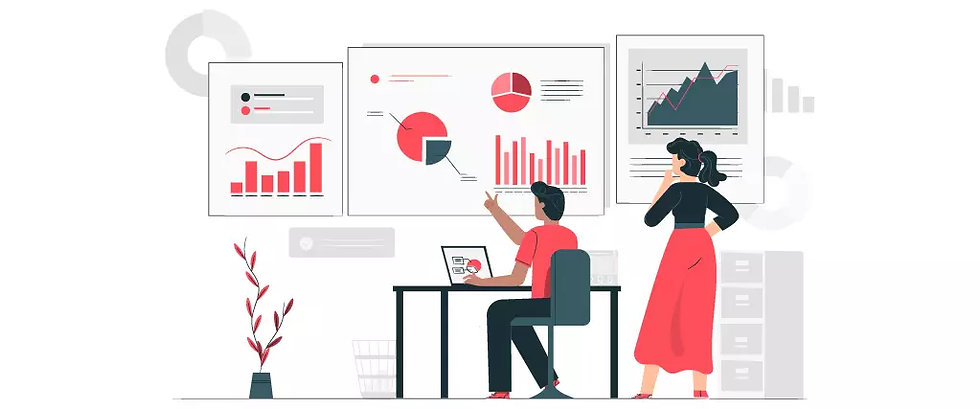Data Visualization with Python: Unveiling Insights through Graphics
- Bambino Mariefort

- Sep 22, 2023
- 3 min read
Updated: Sep 24, 2023

Introduction
In today's data-driven world, the ability to convey complex information effectively is paramount. Data visualization plays a crucial role in transforming raw data into understandable, actionable insights. Python, a versatile and popular programming language, offers a rich ecosystem of libraries and tools for creating compelling and informative data visualizations. In this blog, we'll explore the power of data visualization with Python and how it can be harnessed to unlock the potential of your data.

Why Data Visualization Matters
Data visualization is the art of representing data graphically, allowing patterns, trends, and insights to emerge more clearly than with raw numbers or text. Here's why it matters:
1. Clarity and Understanding: Visualizations simplify complex data, making it easier for stakeholders to grasp information quickly and accurately.
2. Pattern Discovery: Visualizations reveal hidden patterns and correlations within data that may not be apparent through other means.
3. Storytelling: Visualizations can tell a story, guiding viewers through data, helping them understand the context and significance of the information.
4. Decision-Making: Data visualizations aid in decision-making processes, enabling data-driven decisions that can lead to improved outcomes.
Python's Data Visualization Libraries
Python boasts a diverse set of libraries for creating data visualizations. Some of the most popular ones include:
1. #Matplotlib: This library is a versatile and foundational tool for creating a wide range of static, animated, and interactive plots and charts.
2. #Seaborn: Built on top of Matplotlib, Seaborn simplifies the process of creating attractive and informative statistical visualizations.
3. #Pandas: While primarily a data manipulation library, Pandas includes built-in data visualization capabilities that are great for quick exploratory data analysis.
4. #Plotly: Plotly is known for its interactive and web-friendly visualizations, making it a powerful choice for creating dashboards and online data applications.
5. #Bokeh: Bokeh is another interactive visualization library that is well-suited for creating web-based, interactive plots.
6. #Altair: Altair is a declarative statistical visualization library that simplifies the creation of complex visualizations using a concise, easy-to-understand syntax.

Types of Data Visualizations
Python empowers users to create various types of data visualizations to suit different needs:
1. Bar Charts:
Ideal for comparing categories of data, bar charts are great for visualizing categorical data, such as sales by product or population by city.
2. Line Charts:
Line charts are suitable for showing trends over time, making them valuable for time series data.
3. Scatter Plots:
These plots help visualize the relationship between two numerical variables and are great for identifying correlations.
4. Pie Charts:
Pie charts are useful for showing the composition of a whole, such as market share or demographic distribution.
5. #Heatmaps:
Heatmaps display data in a matrix format, with color intensity representing values, making them excellent for visualizing correlations and patterns in large datasets.
6. #Histograms:
Histograms show the distribution of a single variable, helping to understand its frequency and range.
7. Box Plots:
Box plots are used to visualize the distribution of a dataset and identify outliers and skewness.

Data Visualization Workflow in Python
Creating data visualizations in Python typically involves the following steps:
1. Data Preparation: Start by importing and cleaning your data using libraries like Pandas.
2. Choosing the Right Visualization: Select the appropriate type of visualization for your data and goals.
3. Creating the Plot: Use Python libraries like Matplotlib, Seaborn, or Plotly to generate the visualization.
4. Customization: Tailor the visualization to improve readability and aesthetics by adjusting labels, colors, and styles.
5. Adding Context: Add titles, legends, and annotations to provide context and clarity to the visualization.
6. Interactivity (if needed): For web-based or interactive visualizations, incorporate interactive elements using libraries like Plotly or Bokeh.
7. Sharing and Presentation: Save or export the visualization for sharing in reports, presentations, or online dashboards.

Real-World Applications
Data visualization with Python finds applications across various domains:
1. Business Analytics: Analyze sales data, customer behavior, and market trends to make informed business decisions.
2. Healthcare: Visualize patient data, medical records, and clinical outcomes to improve patient care and research.
3. Finance: Analyze financial data, stock market trends, and portfolio performance for investment decisions.
4. Environmental Science: Visualize climate data, pollution levels, and environmental trends to study and address environmental issues.
5. Social Sciences: Use visualizations to explore sociological, psychological, and demographic data.
Conclusion
Data visualization is a powerful tool for making data accessible, understandable, and actionable. Python's extensive library ecosystem, combined with its simplicity and versatility, makes it an excellent choice for data visualization projects. Whether you're a data scientist, analyst, researcher, or business professional, harnessing the power of data visualization with Python can enhance your ability to extract valuable insights and tell compelling stories from your data.



Comments